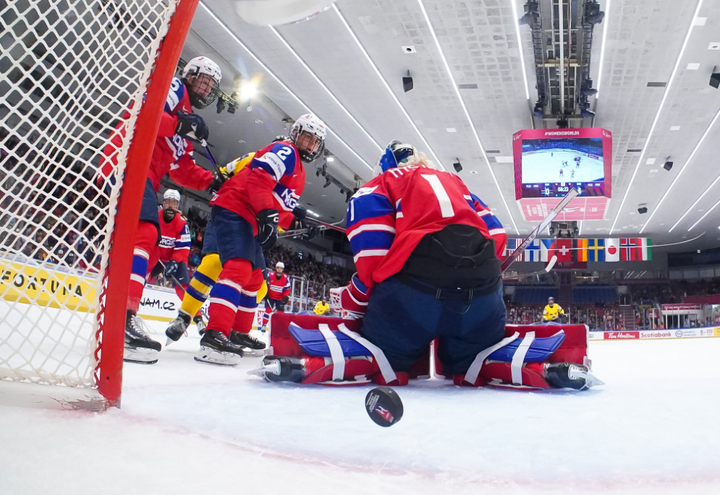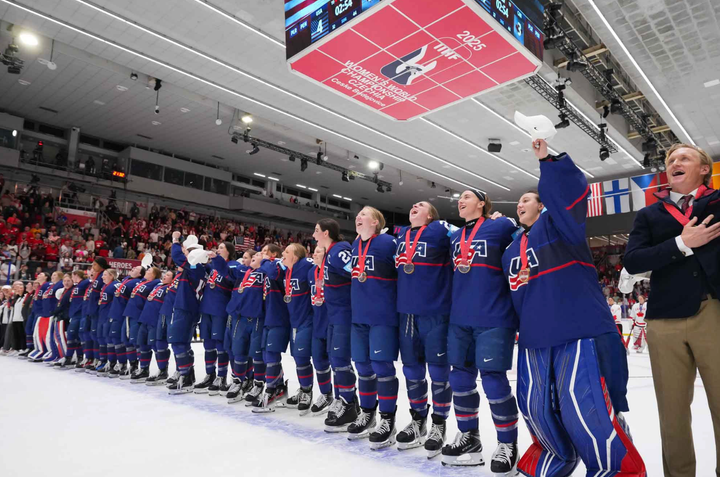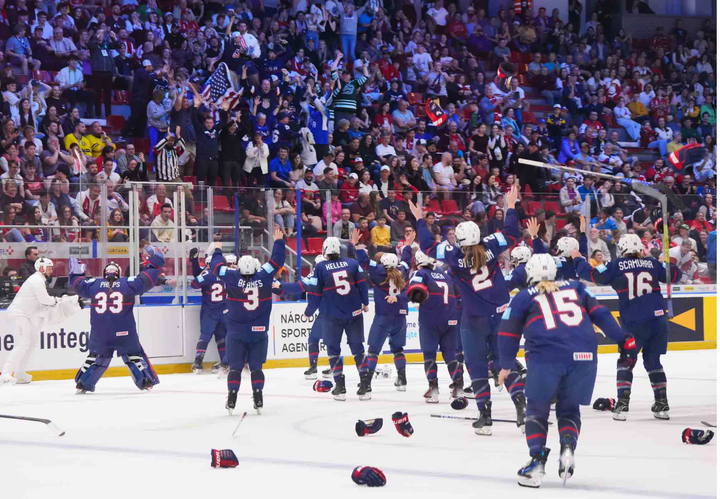Selecting the All-Time CWHL Second Team
Another group of the best of the best to play in the CWHL
Yesterday we presented The Ice Garden’s CWHL All-Time First Team. That squad of featured forwards Marie-Philip Poulin, Caroline Ouellette, and Jayna Hefford; defenders Catherine Ward and Cathy Chartrand; and the nearly-impervious Charline Labonté between the pipes.
Today, we’re concluding this two-part series with the presentation of The Ice Garden’s CWHL All-Time Second Team. But that’s not all, at the end of this piece you’ll find the players who made the cut for our All-Time Third Team, which is headlined by former general manager of the Toronto Furies Sami Jo Small and Team USA superstar Brianna Decker.
Again, a special thank you to Michelle Jay, Meredith Foster, Eleni Demestihas, Kirsten Whelan, Jared Book, and @Baseball_Annie_ for participating in the media voting. It was no small task to whittle down the hundreds of players who have played in the CWHL to a list of just a dozen players. This process would have been next to impossible without their insight and, more importantly, their coverage and the coverage of many others over the years.
The Second Team
Ann-Sophie Bettez
Bettez was named the league’s Rookie of the Year when she burst onto the scene with 17 goals and 16 assists in the 2012-13 campaign. What followed was an outstanding seven-year career which culminated in a Clarkson Cup victory in 2017.
It’s hard to believe that Bettez has only recently returned to the fold with the Canadian women’s national team given how dominant she was during her CWHL career. Amazingly, Bettez notched 33 or more points in six of her seven seasons in the league. That history of production is a clear indication not only of her consistency, but also of her skill and poise. When other Montréal stars like Marie-Philip Poulin were centralized with Team Canada in 2014 and 2018, Bettez took on the mantle of Les Canadiennes’ top skater with grace.
Bettez was named the CWHL’s MVP in 2014 and took home the Angela James Bowl after scoring 40 points in 23 games. In 2018, she finished third in scoring (behind Kelli Stack and Cayley Mercer) when she scored 19 goals in a season for the second time in her career.
A savvy, undersized winger, Bettez plays much bigger than her 5-foot-4 frame. She scores goals from almost everywhere in the offensive zone and has no qualms with going hard to the net, providing screens, or taking a cross-check or two if it means getting her stick to a rebound. But make no mistake, she is also more than capable of beating defenders one-on-one and making highlight reel plays. Bettez can do it all.
Bettez is, without a doubt, one of the greatest CWHL players of all-time. One could make the case that her excellence was all the more noteworthy because of her lengthy and controversial omission from Team Canada. Her brilliance in the CWHL in the 2013-14 and 2017-18 seasons not only proved that she was so much more than Poulin’s linemate, it was clear evidence of the quality and depth of talent in professional women’s hockey.
The Quebec native is second all-time in career points (263), behind only Caroline Ouellette. Bettez is one of just 11 players to record 40 or more points in a season and one of just five players to accomplish that feat three times during their career.
Jennifer Botterill
Botterill won the first-ever Angela James Bowl by scoring 30 goals and 31 assists in 36 games in the 2007-08 season. The Harvard alumna and Team Canada star made a seamless transition from the Canadian National Women’s Hockey League with the Toronto Aeros to the CWHL with the Mississauga Aeros/Chiefs and, in her final season, the Toronto Furies.
Botterill, like Jayna Hefford, was one of the CWHL’s brightest and earliest stars. Her success in the upstart league came as little surprise. Botterill remains the only player to ever win the prestigious Patty Kazmaier Award twice during her collegiate career and won a silver with Canada in the 1998 Olympics and gold in 2002 and 2006 before her CWHL career began.
Originally a gifted ringette player, the smooth-skating 5-foot-9 winger absolutely piled up points in the three years she played in the CWHL. She never finished lower than third in scoring in her three years in the league and scored at least 24 goals in her first two seasons. She and Meghan Agosta are the only two women to play at least two seasons and finish their careers with over 2.00 points per-game. Agosta’s 2.52 Pts/GP was a cut-above Botterill’s 2.03 Pts/GP, but it’s worth noting that Botterill played 26 more games in her career.
When she hung up her skates after the 2010-11 season, Botterill’s 154 points in 76 games ranked second all-time behind only Hefford. When the CWHL closed its doors, she was sixth all-time in points and had the highest Pts/GP in the top-10. Botterill is also just one of 12 women who are members of the league’s 60-60 club, as she finished her career with 62 goals and 92 assists.
Meghan Agosta
We saw a lot of epic individual seasons in the history of the CWHL, but Agosta’s 41-goal, 39-assist campaign in 2011-12 was a masterpiece. Honestly, it’s hard to wrap your ahead around the fact that Agosta put up 80 points in only 27 games that year — that’s just shy of 3.00 Pts/GP. That, my friends, is simply bonkers.
What’s even more amazing is that, according to Jeff Craig’s CWHL Tracker, 66 of the points that Agosta notched that season were primary and 52 of those primary points were picked up at even strength. This feels like a good time to mention that you can count the number of 50-point seasons in the CWHL on two hands.
Unsurprisingly, she was named the CWHL’s Most Valuable Player in her rookie season, where she led the Montréal Stars to a Clarkson Cup victory with four goals and two assists in our playoff games. After that unforgettable debut, Agosta won her second Angela James Bowl in her second and final CWHL season by scoring 16 goals and setting up 30 others in 23 games. The fact that she scored her 100th point in the league in her second season really tells you all you need to know about just how brilliant Agosta was in the CWHL.
So, what made her so dangerous? Agosta, who still plays with Team Canada, has one of the nastiest and most accurate shots in the world. As if that doesn’t make her dangerous enough, she’s also a fast, slippery skater who has a knack for getting past defenders with and without the puck. Agosta seems to know right where she needs to be to get to the puck in all three zones, which is a gift that only the best players in the world are blessed with.
GOAL! Meghan Agosta breaks the scoreless tie on the power play with 12:42 remaining in the 2nd period. It's 1-0 Canada. #USAvsCAN #PyeongChang2018 pic.twitter.com/i4erz7WpHG
— Jonathan Kabana (@JonathanKabana) February 15, 2018
It’s a shame that we only got to see two seasons of Agosta absolutely dominate the CWHL with Montréal. If Team Canada’s favorite cop stayed in the league for a few more seasons she could have easily finished in the top-three in scoring all-time. One of the most impressive stats in league history is that Agosta hit 100 primary points in 50 career regular season games.
Laura Fortino | Defender
Fortino made her CWHL debut at the age of 18 with the Burlington Barracuda on Nov. 29, 2008. Although she played in just three games, she managed to pick up a point and put Hockey Canada and the CWHL on notice by proving herself against grown women before beginning her collegiate career at Cornell.
She returned to the league and joined the Thunder in the 2014-15 season, after winning gold with Canada at the Sochi Olympics. What followed was half a decade of standout play for the Thunder franchise, culminating in the Best Defenceman of the Year award in 2016 and a Clarkson Cup victory in 2018.
Regrettably, we don’t have reliable tools to measure the quality of play for defenders, especially for CWHL alumnae. With that being said, Fortino has accumulated a mountain of evidence both in the CWHL and with Team Canada that she is an outstanding defensive defender. She effortlessly led the national team in TOI/GP in Pyeongchang and at the 2019 Worlds, which came as little surprise to those who watched her eat up minutes for the Thunder.
In addition to her acumen in her own zone, Fortino is also an underrated puck-mover. She put up at least 15 points, and 10 primary points, in every full season she played with the Thunder. Fortino’s career 0.82 Pts/GP puts her in an elite class with Cathy Chartrand, Catherine Ward and Gigi Marvin as the most productive defenders in the history of the league.
Never one to leave her goalie(s) stranded, Fortino made most of her impact on the scoreboard on special teams. At least 30 of her 82 career points were picked up when her team was on the power play. She had at least six power play points in all four of her full seasons with the Thunder — a testament to her consistent play on both sides of the ice.
Fortino’s 82 career points ranks second all-time among full-time defenders, behind only Chartrand. She was just 28 when the 2018-19 season concluded, so there’s a very good chance that Fortino could have caught Chartrand if she played two or more three seasons in the CWHL.
Becky Kellar | Defender
Kellar played in the Canadian NWHL for seven seasons before the CWHL came into existence. If we took her accomplishments in the NWHL into consideration, Kellar would almost certainly be on the CWHL’s All-Time First Team. With that being said, she was still a lock for the The Ice Garden’s Second Team.
It’s worth noting that Kellar had already won three of her four Olympic medals before her CWHL debut, and that she was 31 when she played her first season for her hometown Burlington Barracudas. So, it came as little surprise when her production dropped from 0.47 Pts/GP in her first two seasons to just 0.14 Pts/GP in 2010-11. For those who are curious: Kellar averaged 0.55 Pts/GP in the NWHL.
To put it simply: Kellar was one of the best defenders in CWHL history. She earned honors as the CWHL’s Top Defender in the first two years of the league’s history. When the league closed its doors nearly a decade after her retirement, she was still the only defender to ever win the award in back-to-back seasons.
When Kellar retired, she had over twice as many points as the Barracudas’ second all-time leader in points among defenders — and she wasn’t even known for her offensive production. Her balanced, physical style of play with Burlington set the standard for defensive excellence in the CWHL for years. She’s an all-time great.
Geneviève Lacasse | Goaltender
Lacasse played for three different teams during her CWHL career, but is best known for the excellence of her play with the Boston Blades. She backstopped the Boston Blades to two Clarkson Cups in her first two full seasons in the CWHL.
As a rookie, Lacasse earned honors as the CWHL’s Top Goaltender of the Year in 2013. Lacasse was one of the league’s best goalies throughout her career. To best understand just how great she was in the CWHL, one needs only look at her play in the 2015-16 season.
Before that season began, the majority of the Blades’ best players left the team to join Dani Rylan’s NWHL. In other words, the Blades’ roster was absolutely gutted. Lacasse went from having a championship-winning team playing in front of her to a roster that was filled with members of Team USA’s inline hockey team. Needless to say, the goaltender faced an avalanche of shots that year.
Lacasse was in net for 22 losses with the Blades that season, but somehow managed to put up a .909 save percentage and finish second in the league in quality starts. (13). That save percentage is made all the more exceptional when you consider the fact that she faced a staggering 50.5 shots against per-60 minutes (SA60) that year. She may have won just once that season, but she was more or less a wall for Boston.
Lacasse played the next season in Calgary, where she posted a .923 save percentage while facing 26.1 SA60. She and the Inferno made it to the Clarkson Cup Final that year, but fell to Les Canadiennes de Montréal. Two years and one Olympic silver medal later, she played her final season as the backup to Emerance Maschmeyer on Montréal.
Clearly, Lacasse was lights-out in the regular season throughout her CWHL career, but she was even better in the playoffs. Regardless of what the next chapter of professional women’s hockey in North America looks like, Lacasse’s 7-0 career record and 0.99 GAA in the postseason should never be forgotten.
The Third Team
As it turns out, we had enough media selections to establish an All-Time CWHL Third Team, which is not altogether surprising considering how many great players skated in the league. In lieu of offering a list of players who also received votes, here is what the All-Time Third Team looks like.
Forwards: Brianna Decker, Rebecca Johnston, Noémie Marin
Defenders: Meaghan Mikkelson, Kacey Bellamy
Goaltender: Sami Jo Small
Reflections
It’s important to note that the definition of “greatness” was intentionally left open to interpretation for the media members who participated in the voting. There are many definitions of greatness, which is why we wanted to see which players would receive the most votes if we kept that definition as general as possible.
Needless to say, some of the best players who have ever played the game — let alone played in the CWHL — did not make the cut. The fact that icons like Natalie Spooner, Brianne Jenner, Kelli Stack, Julie Chu, Kim St-Pierre, Maschmeyer and others are not featured on these teams might be shocking to some, but by no means should it be used to discredit their careers and the role that they have played and continue to play in the growth of the game.
We saw a lot of talented players step on and off CWHL ice over the years. Fixtures like bruising defender Shannon Moulson and three-time Clarkson Cup champion Emmanuelle Blais are as much a part of the league’s history as stars like Gillian Apps and Jamie Lee Rattray. The history of the CWHL would be incomplete without acknowledging the dedication and sacrifice of every player to ever lace up their skates for a try-out, a practice or a game.
All data courtesy of Richard Scott’s Who’s Who in Women’s Hockey Guide, eliteprospects.com, Giants in the Crease, Jeff Craig’s CWHL Tracker, and the author’s own tracking.





Comments ()